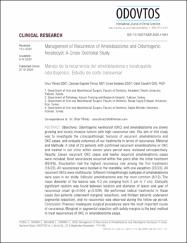| dc.contributor.author | Yılmaz, Onur | |
| dc.contributor.author | Yılmaz, Zeynep Sağnak | |
| dc.contributor.author | Balaban, Emre | |
| dc.contributor.author | Çandırlı, Celal | |
| dc.date.accessioned | 2020-12-19T19:32:28Z | |
| dc.date.available | 2020-12-19T19:32:28Z | |
| dc.date.issued | 2020 | |
| dc.identifier.citation | Yilmaz, O., Sagnak Yilmaz, Z., Balaban, E., & Candirli, C. (2020). Management of Recurrence of Ameloblastoma and Odontogenic Keratocyst: A Cross-Sectional Study. Odovtos - International Journal of Dental Sciences, 22(3), 174–186. https://doi.org/10.15517/ijds.2020.41564 | en_US |
| dc.identifier.issn | 1659-1046 | |
| dc.identifier.issn | 2215-3411 | |
| dc.identifier.uri | https://doi.org/10.15517/IJDS.2020.41564 | |
| dc.identifier.uri | https://hdl.handle.net/11436/1027 | |
| dc.description | YILMAZ, Onur/0000-0002-0460-7649; Yilmaz, Zeynep Sagnak/0000-0002-3225-2486 | en_US |
| dc.description | WOS: 000560071200021 | en_US |
| dc.description.abstract | Objectives: Odontogenic keratocyst (OKC) and ameloblastoma are slowly growing and locally invasive tumors with high recurrence rate. the aim of this study was to investigate the clinicopathologic features of recurrent ameloblastoma and OKC cases, and evaluate outcomes of our treatments in terms of recurrence. Material and Methods: A total of 23 patients with confirmed recurrent ameloblastoma or OKC and treated in our clinic within eleven years period were reviewed retrospectively. Results: Eleven recurrent OKC cases and twelve recurrent ameloblastoma cases were included. Most recurrences occurred within five years after the initial treatment (69.6%). Enucleation had the highest recurrence rate among the first treatments (18/23). All recurrences were located in the mandible, with one exception (22/23). All recurrent OKCs were multilocular. Different histopathologic subtypes of ameloblastoma were seen in our study, follicular ameloblastoma was the most common (8/12). the mean diameter of the lesions was 4.3 cm (ranging from 2 cm to 7 cm). Statically significant relation was found between location and diameter of lesion and year of recurrence onset (p=0.004; p=0.026). We performed radical treatments in these cases (ten patients underwent marginal resections, and thirteen patients underwent segmental resection), and no recurrence was observed during the follow-up period. Conclusion: Previous inadequate surgical procedures were the most important cause of recurrence. Marginal or segmental resection with safety margins is the best method to treat recurrences of OKC or ameloblastoma cases. | en_US |
| dc.language.iso | eng | en_US |
| dc.publisher | Univ Costa Rica, Fac Odontologia | en_US |
| dc.rights | info:eu-repo/semantics/openAccess | en_US |
| dc.subject | Odontogenic tumours | en_US |
| dc.subject | Odontogenic cysts | en_US |
| dc.subject | Recurrence | en_US |
| dc.subject | Conservative treatment | en_US |
| dc.subject | Margins of excision | en_US |
| dc.subject | Resection | en_US |
| dc.title | Management of recurrence of ameloblastoma and odontogenic keratocyst: A cross-sectional study | en_US |
| dc.type | article | en_US |
| dc.contributor.department | RTEÜ, Diş Hekimliği Fakültesi, Klinik Bilimler Bölümü | en_US |
| dc.contributor.institutionauthor | Balaban, Emre | |
| dc.identifier.doi | 10.15517/IJDS.2020.41564 | |
| dc.identifier.volume | 22 | en_US |
| dc.identifier.issue | 3 | en_US |
| dc.identifier.startpage | 174 | en_US |
| dc.identifier.endpage | 186 | en_US |
| dc.ri.edit | oa | en_US |
| dc.relation.journal | Odovtos International Journal of Dental Sciences | en_US |
| dc.relation.publicationcategory | Makale - Uluslararası Hakemli Dergi - Kurum Öğretim Elemanı | en_US |


















